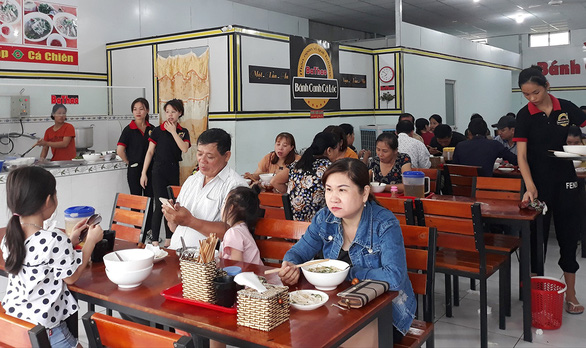As the effects of COVID-19 drag into 2021, the majority of food and beverage businesses in Vietnam have to tread water, resorting to personnel lay-offs, downscaling or business remodeling in the hope of reaching a 'new normal' era.
Those who survived 2020 are picking up steam this year thanks to a drop in property rental costs, among other factors.
Located in Ho Chi Minh City’s Tan Binh District, Thien Hong Phat, a seafood restaurant, has managed to pull through so far by laying off 70 percent of its workforce.
According to Nguyen Hoang Minh, chief operating officer at Thien Hong Phat, the lay-off reduced salary expenditure by 20-30 percent, while productivity remained unchanged.
“The management chose to reschedule shifts and allot the salary budget to the remaining staffers, helping them earn more with the workload they’ve taken up,” Minh explained.
On top of that, the restaurant also rolled out various sales campaigns, including an up-to-20 percent discount on products, new all-inclusive dinner packages, as well as catering services.
The solutions paid off, as Thien Hong Phat started to record a net profit, while current customer footfall recovered to 70-80 percent of the pre-virus figure.
Echoing Thien Hong Phat’s story, the restaurant chain Lau Ga 109 (Chicken Hotpot 109) has closed down six out of its 16 branches in Ho Chi Minh City.
Tran Quoc Thinh, owner of the chain, said one of the closed locations had only operated for two months, which wasted property rent and investment and led to a VND5 billion ($218,000) loss.
To keep the other restaurants afloat, Thinh strived to streamline all unnecessary overhead costs, remapping the customer territory of each location in the franchise, and set new opening hours.
“Thanks to the remodeling, we managed to cut the loss from the peak of VND1.2 billion [$52,334] per month to VND100-200 million [$4,361-8,723],” Thinh revealed.
For others, COVID-19 is considered an opportunity for change.
Hong, owner of a restaurant franchise specializing in the noodle dish mi quang in Binh Thanh District, Ho Chi Minh City, switched his business model to small, scalable branches with a focus on takeaway demand after the coronavirus drove a large part of his restaurants out of business.
“The revenue [of the chain] was down 50 percent, but cost was down too, which is why we still reported a decent profit,” Hong said.
Elastic demand for rental
Hoang Thanh Huong, a restaurateur in Ho Chi Minh City, just terminated a restaurant rental contract in Go Vap District due to unfavorable terms offered by the landlord in the recent renegotiation.
“Our business was down 70 percent from the pre-coronavirus days already, yet they tried to raise the rental by almost two-fold,” Huong complained.
“It’s as if they’re trying to drive us away.”
During the hard times, other firms have also grown to be more sensitive to rent fluctuations.
Quynh, owner of the seafood eatery Happy, moved her restaurant after securing a long-term lease with reasonable pricing, leaving behind the old place whose proprietor did not agree to lower the rent.
“Despite losing some old customers and having to chip in hundreds of millions of dong [VND100 million = $4,361] for redesign, it’s still worth it for a long-run venture,” Quynh denoted.
Finance pundit Dinh The Hien told Tuoi Tre (Youth) newspaper that proprietors tend to hike the rent at the start of a new year, for demand for leases also emerges during this time.
However, as the post-pandemic scenario has rendered many properties vacant, raising rent during this season is not a wise choice, Hien advised.
“As businesses are struggling, especially in downtown districts where food and beverage facilities were hit the hardest, proprietors would not be able to find new renters right away after terminating contracts.”
Pinning hopes
Regarding the shrinking of his chain, Lau Ga 109 owner Thinh sees it as an interim solution that helps a medium-sized firm like his deal with the epidemic’s sweeping knock-on effect.
In the long run, he has already had in mind an expansion plan, with as many as 50 branches to be up and running by 2022 and beyond, by distributing his franchise rights to other restaurateurs.
“We are still keeping our fixed overhead for the ten remaining restaurants at around VND1.2 billion per month, which will help us survive four or five more months until a breakthrough opportunity comes,” Thinh anticipated.
Also keeping up high hopes, Nguyen Thi Thao, owner of the snakehead fish noodle soup restaurant franchise Ba Thao, is looking to open more branches despite seeing a 40 percent drop in customer footfall.
As Thao sees it, opening more small-sized offshoots would be the optimal choice to promote her brand and build her customer base, as well as cutting costs.
“As long as [the brand] lives, I have hope,” Thao declared.
Ha Binh Kha, owner of the restaurant chain Hai Chau, is also leveraging the post-pandemic scenario for his brand’s growth, as he just opened more branches thanks to favorable rental contracts.
“Our rentals dropped by 30 percent compared to the pre-COVID days, with contracts going up to five years,” Kha stated.
“Many restaurants were out of business, but it also means customer demand will be distributed to the survivors.
"As long as we keep up the good management and utilize online sales, we won’t have to worry about any lack of customers.”
Like us on Facebook or follow us on Twitter to get the latest news about Vietnam!


















































